Gain Enhancement of Microstrip Patch Array Antennas Using Two Metallic Plates for 24 GHz Radar Applications
Abstract
:1. Introduction
2. Designing the 4 × 1 Microstrip Square Patch Array Antenna
2.1. The Single Microstrip Square Patch Antenna
2.2. Designing 4 × 1 Shunt-Connected Series Feed Networks Using Uniform and Tapered Power Distributions
2.2.1. Uniform Power Distribution
2.2.2. Tapered Power Distribution
2.3. Performance of the 4 × 1 Microstrip Square Patch Array Antenna Combined with Shunt-Connected Series Feed Networks Using Uniform and Tapered Power Distributions
3. Design of 4 × 1 Microstrip Square Patch Array Antenna Appended with Two Metallic Plates
3.1. Effects from the Tilting Angle when the Metallic Plate Length Is 10 mm
3.2. Effects from the Length of the Metallic Plates when θ = 70°
4. Experiment Results and Discussion
5. Conclusions
Author Contributions
Funding
Data Availability Statement
Conflicts of Interest
References
- Skolnik, F.; Merrill, I. Introduction to Radar: Radar Handbook; McGraw-Hill: New York, NY, USA, 1962. [Google Scholar]
- James, R.J. A history of radar. IEE Rev. 1989, 35, 343–349. [Google Scholar] [CrossRef]
- Greco, M.S.; Li, J.; Long, T.; Zoubir, A. Advances in radar systems for modern civilian and commercial applications: Part 1 [From the Guest Editors]. IEEE Signal Process. Mag. 2019, 36, 13–15. [Google Scholar] [CrossRef]
- Lin, J.; Li, C.; Chang, C.C.; Tsai, T.; Zito, D.; Chang, S.F. Review—Semiconductor integrated radar for sensing applications. ECS J. Solid State Sci. Technol. 2018, 7, 3126–3142. [Google Scholar] [CrossRef]
- Chipengo, U.; Krenz, P.M.; Carpenter, S. From antenna design to high fidelity, full physics automotive radar sensor corner case simulation. Model. Simul. Eng. 2018, 2018, 4239725. [Google Scholar] [CrossRef] [Green Version]
- Sabery, S.M.; Bystrov, A.; Navarro-Cía, M.; Gardner, P.; Gashinova, M. Study of low terahertz radar signal backscattering for surface identification. Sensors 2021, 21, 2954. [Google Scholar] [CrossRef]
- Xiao, L.; Xie, Y.; Gao, S.; Li, J.; Wu, P. Generalized radar range equation applied to the whole field region. Sensors 2022, 22, 4608. [Google Scholar] [CrossRef] [PubMed]
- Edde, B. RADAR: Principles, Technology, Applications; Prentice Hall, Inc.: Englewood Cliffs, NJ, USA, 1993. [Google Scholar]
- Menzel, W.; Moebius, A. Antenna concepts for millimeter-wave automotive radar sensors. Proc. IEEE 2012, 100, 2372–2379. [Google Scholar] [CrossRef]
- Aydemir, A.E. Development of K Band Microstrip Patch Antenna Array for Traffic Radars. Master’s Thesis, Middle East Technical University, Ankara, Turkey, 13 November 2017. [Google Scholar]
- Errifi, H.; Baghdad, A.; Badri, A.; Sahel, A. Design and analysis of directive microstrip patch array antennas with series, corporate and series-corporate feed network. Int. J. Electr. Electron. Eng. 2015, 3, 416–423. [Google Scholar] [CrossRef] [Green Version]
- Trentini, G.V. Partially reflecting sheet arrays. IRE Trans. Antennas Propag. 1956, 4, 666–671. [Google Scholar] [CrossRef]
- Nguyen, T.K.; Park, I. Design of a low-profile, high-gain Fabry-Perot cavity antenna for Ku-band applications. J. Electromagn. Eng. Sci. 2014, 14, 306–313. [Google Scholar] [CrossRef]
- Goudarzi, A.; Honari, M.M.; Mirzavand, R. Resonant cavity antennas for 5G communication systems: A review. Electronics 2020, 9, 1080. [Google Scholar] [CrossRef]
- Aqlan, B.; Vettikalladi, H.; Alkanhal, M. Millimeter wave antenna with frequency selective surface (FSS) for 79 GHz automotive radar applications. Int. J. Microw. Wirel. Technol. 2017, 9, 281–290. [Google Scholar] [CrossRef]
- Yang, X.X.; Tan, G.N.; Han, B.; Xue, H.G. Millimeter wave Fabry-Perot resonator antenna fed by CPW with high gain and broadband. Int. J. Antennas Propag. 2016, 2016, 3032684. [Google Scholar] [CrossRef] [Green Version]
- Nguyen, N.T.; Rolland, A.; Boriskin, A.V.; Valerio, G.; Le Coq, L.; Sauleau, R. Size and weight reduction of integrated lens antennas using a cylindrical air cavity. IEEE Trans. Antennas Propag. 2012, 60, 5993–5998. [Google Scholar] [CrossRef]
- Malik, B.T.; Doychinov, V.; Zaidi, S.A.R.; Robertson, I.D.; Somjit, N. Antenna gain enhancement by using low-infill 3D-printed dielectric lens antennas. IEEE Access. 2019, 7, 102467–102476. [Google Scholar] [CrossRef]
- Ahmad, W.; Dayi, F.; Rehman, H.; Khan, W. Low-cost and small size millimeter wave (24 GHz) extended hemispherical lens antenna for automotive and industrial applications using FR408HR substrate. Prog. Electromagn. Res. Lett. 2021, 100, 73–80. [Google Scholar] [CrossRef]
- Poyanco, J.M.; Pizarro, F.; Rajo-Iglesias, E. Cost-effective wideband dielectric planar lens antenna for millimeter wave applications. Sci. Rep. 2022, 12, 4204. [Google Scholar] [CrossRef] [PubMed]
- Ranga, Y.; Verma, A.K.; Esselle, K.P.; Weily, A.R. Gain enhancement of UWB slot with the use of surface mounted short horn. In Proceedings of the 2010 IEEE Antennas and Propagation Society International Symposium, Toronto, ON, Canada, 2 September 2010; pp. 1–4. [Google Scholar]
- Ononchimeg, S.; Otgonbaatar, G.; Bang, J.H.; Ahn, B.C. A new dual-polarized horn antenna excited by a gap-fed square patch. Prog. Electromagn. Res. Lett. 2011, 21, 129–137. [Google Scholar] [CrossRef] [Green Version]
- Sethi, W.H.; Vettikalladi, H.; Alkanhal, M.A. Millimeter wave antenna with mounted horn integrated on FR4 for 60 GHz Gbps communication systems. Int. J. Antennas Propag. 2013, 2013, 834314. [Google Scholar] [CrossRef] [Green Version]
- Boas, E.C.V.; Ferrero, M.A.S.; Nasri, A.; Mittra, R.; Sodré, A.C. 31 dBi-gain slotted waveguide antenna array using wing-based reflectors. IEEE Access. 2022, 10, 57327–57338. [Google Scholar] [CrossRef]
- Jung, Y.B.; Park, D.Y.; Jung, C.W. Low cost 24GHz patch array antenna for high sensitivity EM sensor. In Proceedings of the 2010 Asia-Pacific Microwave Conference, Yokohama, Japan, 7–10 December 2010; pp. 2208–2211. [Google Scholar]
- Electromagnetic Simulation Solvers, CST Studio Suite. Available online: https://www.3ds.com/products-services/simulia/products/cst-studio-suite/solvers/ (accessed on 28 February 2023).
- Ahmad, S. A Linear Array Design Based on Non-Uniform Chebyshev Distribution for High Gain Low Sidelobe Level Millimetre Wave 5G Applications. Master’s Thesis, Universitat Politècnica de Catalunya·BarcelonaTech, Barcelona, Spain, 31 August 2020. [Google Scholar]
- Rabbani, M.S.; Churm, J.; Feresidis, A.P. Fabry–Perot beam scanning antenna for remote vital sign detection at 60 GHz. IEEE Trans. Antennas Propag. 2021, 69, 3115–3124. [Google Scholar] [CrossRef]
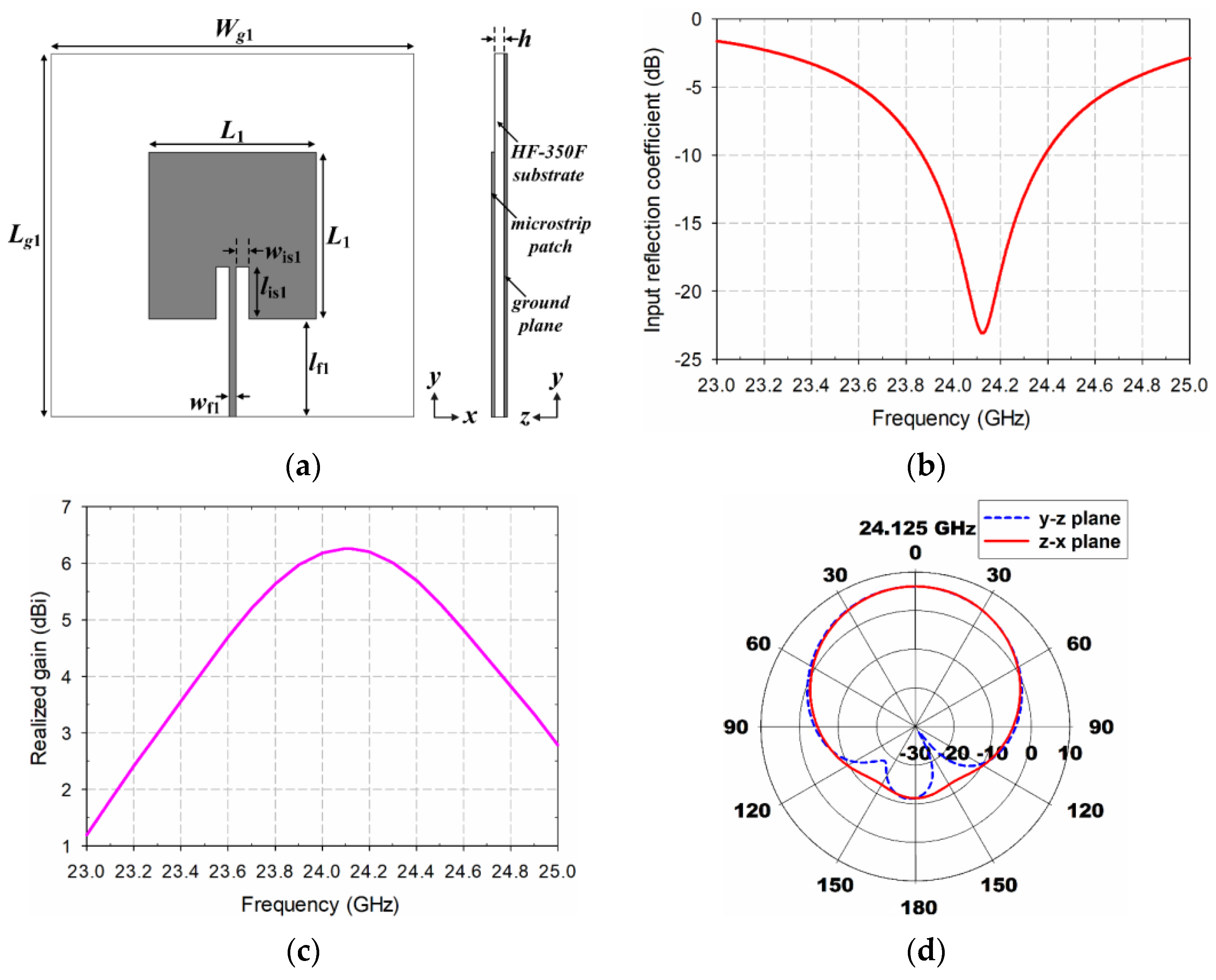



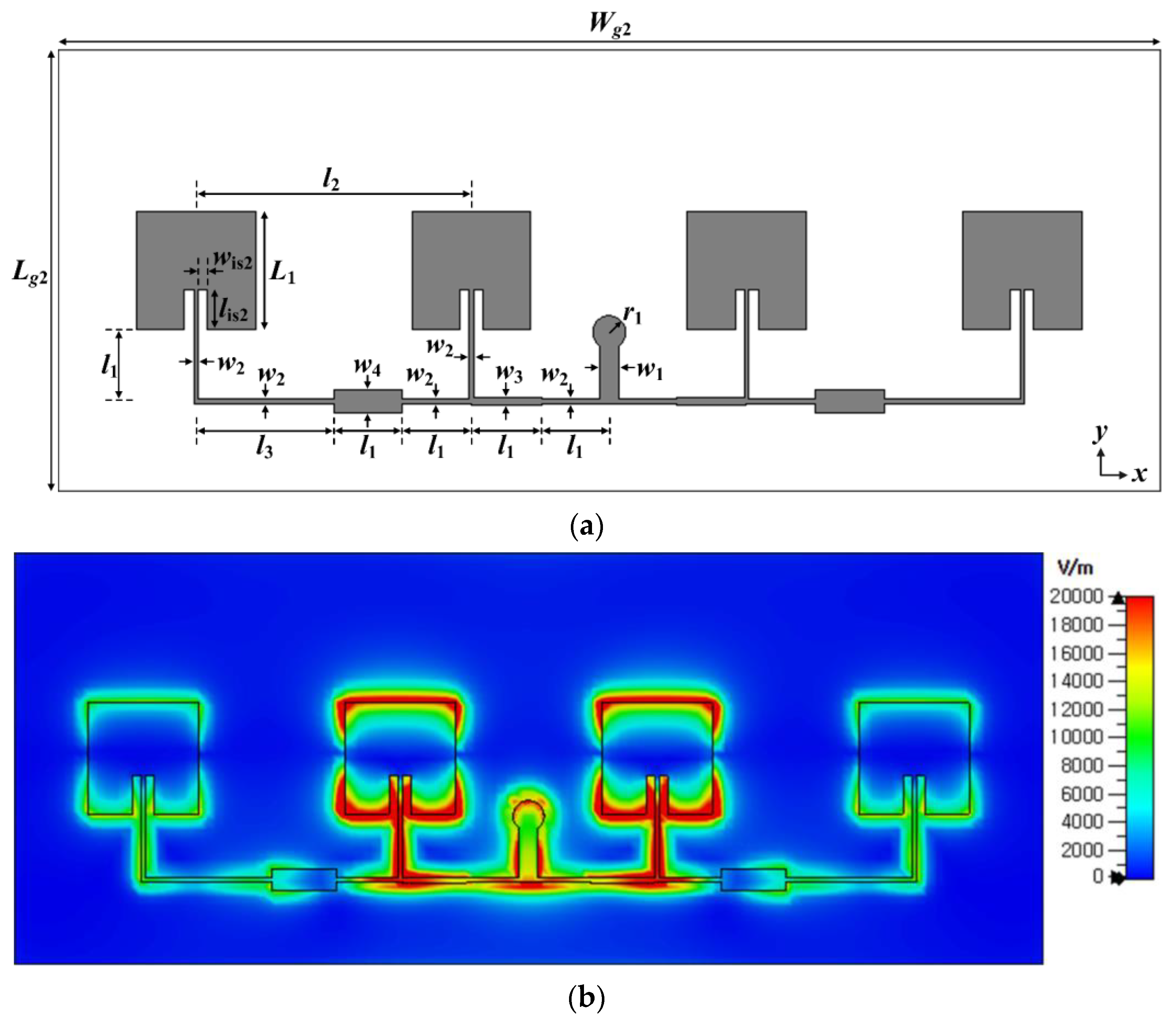


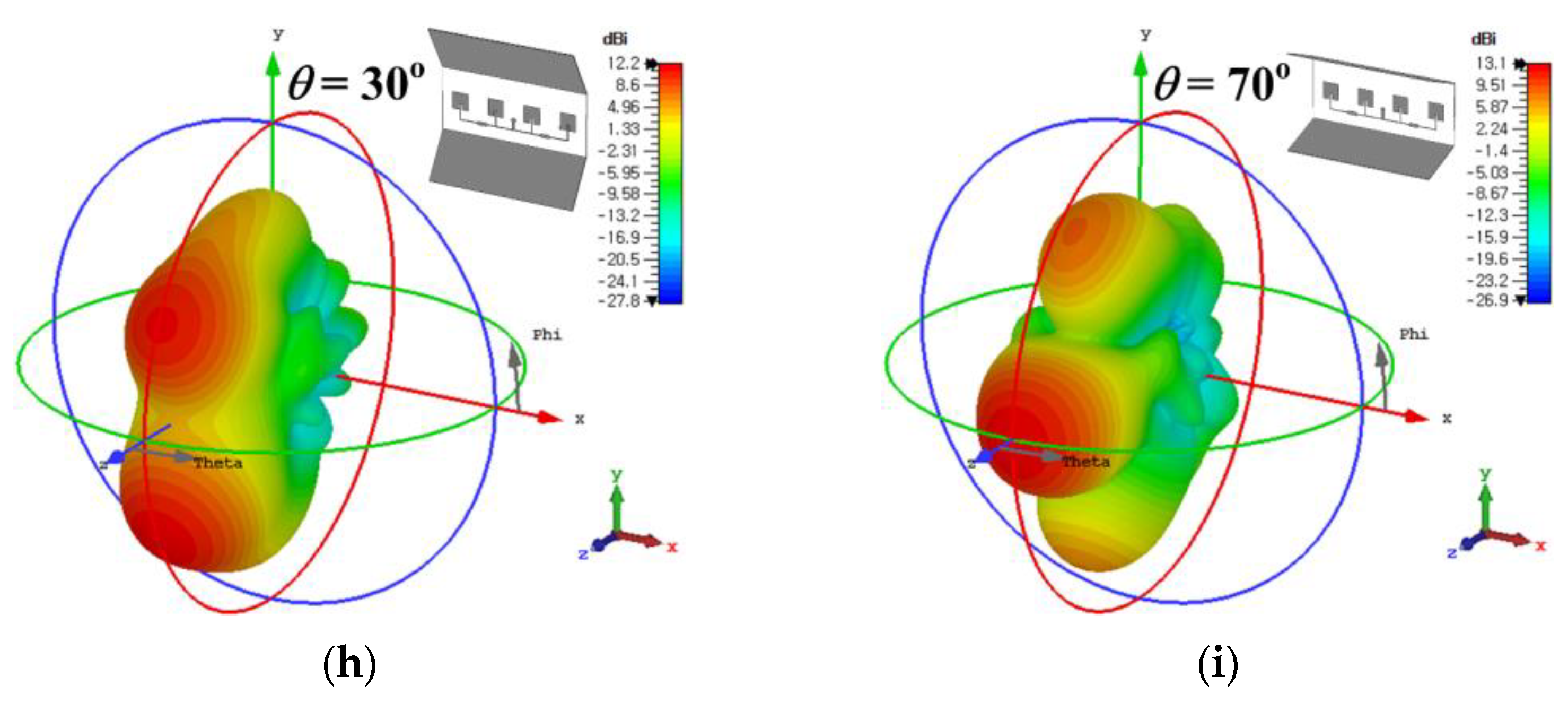


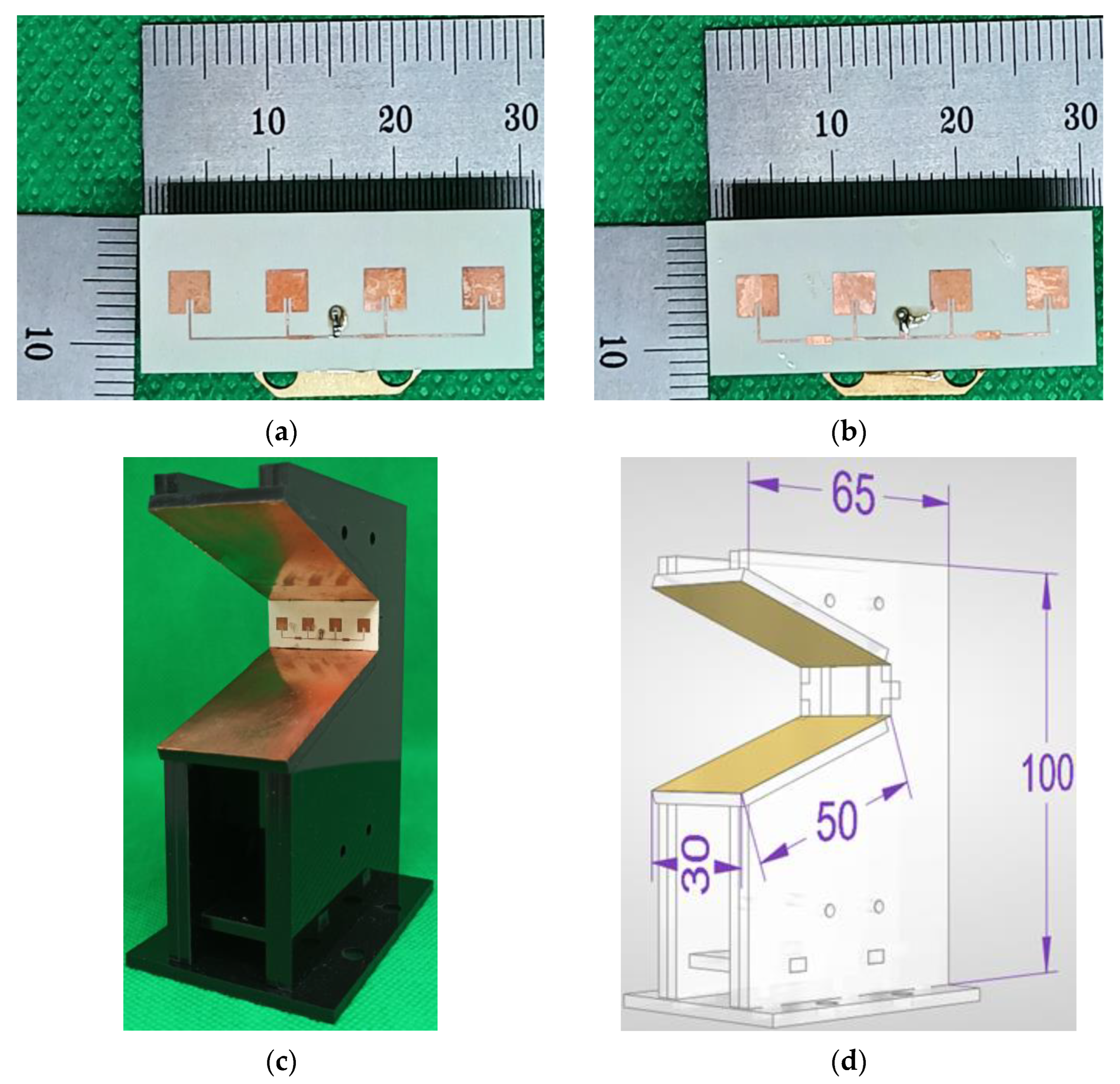
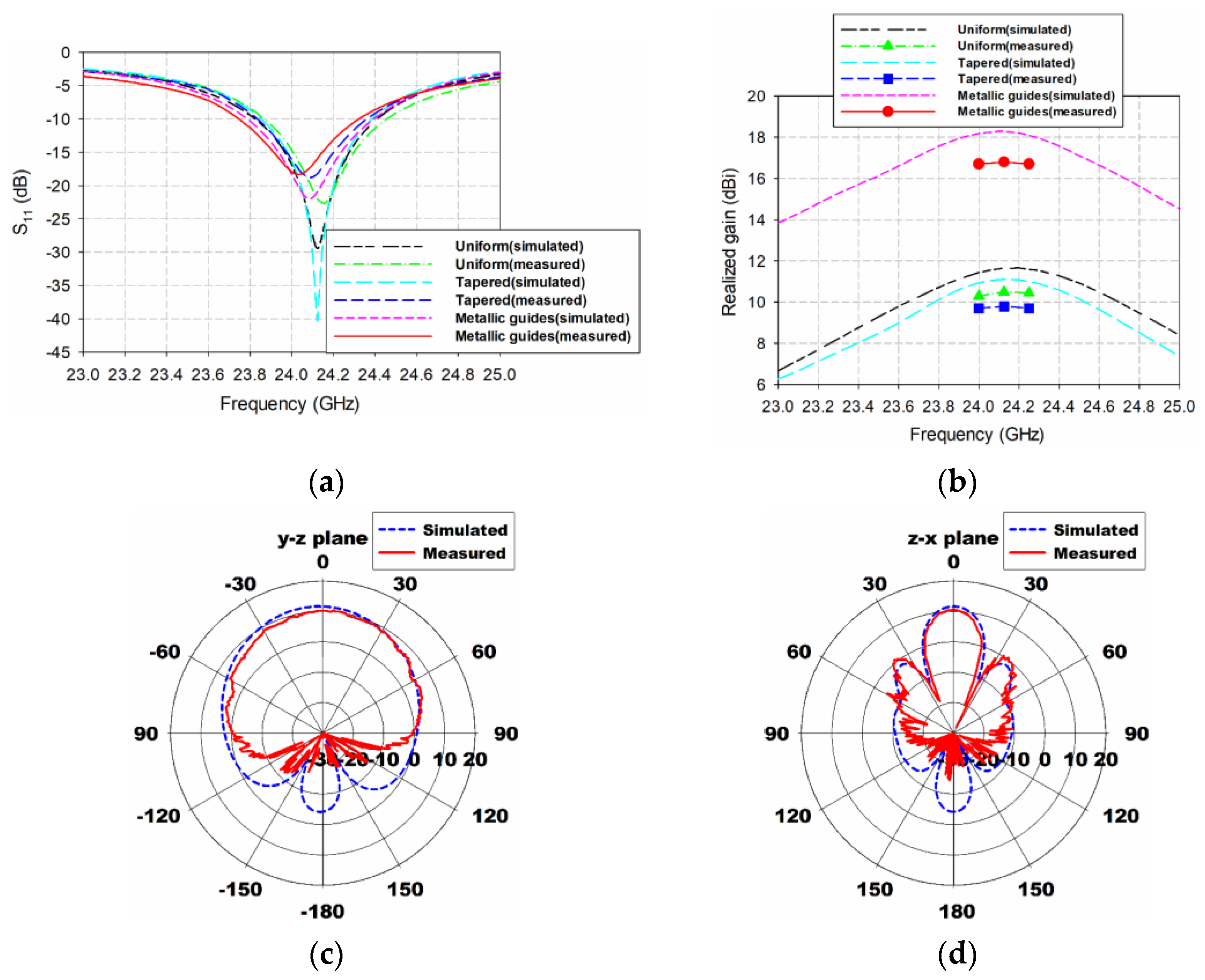

| References | Antenna Type | Physical Dimensions (mm3) | Electrical Dimensions (λ03) | Bandwidth (GHz) for VSWR < 2 | Maximum Gain (dBi) |
|---|---|---|---|---|---|
| [19] | Patch antenna + Hemispherical lens | 65 × 60 × 49 | 5.18 × 4.78 × 3.90 (96.57 λ03) | 23.35–24.45 (fc = 23.9) | 15.2 |
| [20] | Waveguide antenna + Planar graded index lens | 89 × 89 × 32 | 10.09 × 10.09 × 3.63 (369.56 λ03) | 28.0–40.0 (fc = 34.0) | 25.7 |
| [24] | 27 × 1 slot array antenna + Two wing reflectors | 260 × 74 × 54 | 22.33 × 6.36 × 4.64 (658.97 λ03) | 24.94–26.60 (fc = 25.77) | 30.5 |
| [28] | 2 × 1 series-fed patch array antenna + PRS | 50 × 30 × 10 | 10.79 × 6.48 × 2.16 (151.03 λ03) | 62.5–67.0 (fc = 64.75) | 20.1 |
| This Work | 4 × 1 patch array antenna + Two metallic plates | 30 × 46.2 × 47 | 2.40 × 3.70 × 3.77 (33.48 λ03) | 23.35–24.45 (fc = 24.045) | 16.8 |
Disclaimer/Publisher’s Note: The statements, opinions and data contained in all publications are solely those of the individual author(s) and contributor(s) and not of MDPI and/or the editor(s). MDPI and/or the editor(s) disclaim responsibility for any injury to people or property resulting from any ideas, methods, instructions or products referred to in the content. |
© 2023 by the authors. Licensee MDPI, Basel, Switzerland. This article is an open access article distributed under the terms and conditions of the Creative Commons Attribution (CC BY) license (https://creativecommons.org/licenses/by/4.0/).
Share and Cite
Yeo, J.; Lee, J.-I. Gain Enhancement of Microstrip Patch Array Antennas Using Two Metallic Plates for 24 GHz Radar Applications. Electronics 2023, 12, 1512. https://doi.org/10.3390/electronics12071512
Yeo J, Lee J-I. Gain Enhancement of Microstrip Patch Array Antennas Using Two Metallic Plates for 24 GHz Radar Applications. Electronics. 2023; 12(7):1512. https://doi.org/10.3390/electronics12071512
Chicago/Turabian StyleYeo, Junho, and Jong-Ig Lee. 2023. "Gain Enhancement of Microstrip Patch Array Antennas Using Two Metallic Plates for 24 GHz Radar Applications" Electronics 12, no. 7: 1512. https://doi.org/10.3390/electronics12071512






